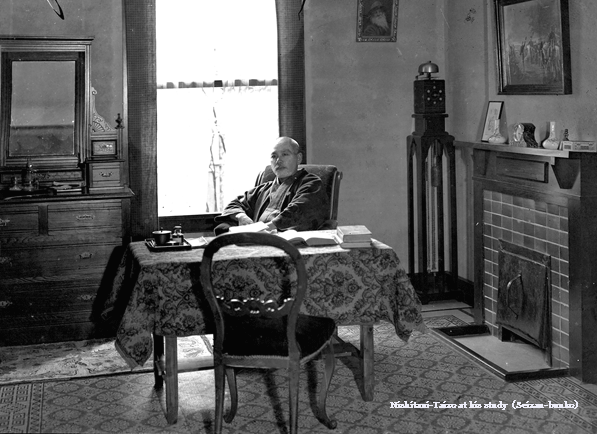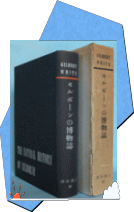遺された『博物誌』の名訳

TAKEMURA-GENBEI, ALIAS NISHITANI-TAIZO
竹村源兵衛、西谷退三となる
AN EXCELLENT TRANSLATION OF SELBORNE LEFT
遺された『博物誌』の名訳

TAKEMURA-GENBEI, ALIAS NISHITANI-TAIZO
竹村源兵衛、西谷退三となる
 ‘I remember visiting this place twice during my stay in England in the
course of the past year. I climbed the Hanger and looked down on White's
old house, The Wakes, from far away.’
‘I remember visiting this place twice during my stay in England in the
course of the past year. I climbed the Hanger and looked down on White's
old house, The Wakes, from far away.’
「訳者も過ぐる年、英国滞留中、二回ほど此の地に足を運び、ハンガーの森に登り、よそながらホワイトの旧居ウェイク荘を眺めた思い出があります」
Nishitani-Taizo wrote these words in the
preface to his translation of Selborne. 'The past year' means 1924. He must have been the first Japanese to climb
the Hanger. Selborne is not so far from London, but it has never been a
convenient place to visit. Today, the road in front of The Wakes is constantly
busy with traffic, but a little back from the road it is a quiet and beautiful
village that even now retains the image of centuries ago.
と西谷退三は『セルボーンの博物誌』の「まへがき」に書いています。「過ぐる年」とは1924(大正13)年でした。ハンガーに登った最初の日本人だったでしょう。セルボーンはロンドンからそう遠くはありませんが交通は不便なところです。今日ではウェイクス荘の前は車の行き来が絶えませんが、そこを少し離れると静かな美しい村で今も何世紀も前の面影を残しているところです。
In the 18th century, a man named Gilbert
White was born in Selborne and lived almost all his life as a curate there.
He observed and recorded the nature of his beloved village and parish and
left us The Natural History and Antiquities of Selborne. The Antiquities
have been almost forgotten, but The Natural History has been read generation
after generation as the bible for naturalists.
18世紀にこの村で生まれ牧師補としてほとんどをここで暮らしたギルバート・ホワイトという人物がいました。愛してやあmないその村や教区の自然の様子を書き残したが『セルボーンの博物誌と古代遺物』です。『古代遺物』の方はほとんど読まれなくなっていますが『博物誌』の方は「自然観察者のバイブル」ともいわれて読み続けられています。
Takemura-Genbei, or Nishitani-Taizo, was 40 years old when he visited Selborne. At that time his English was excellent and he could often even tell jokes in the language. But when he left the Sapporo Agricultural College Preliminary Course and returned home, he would have been unable to read the book without the help of dictionaries. It must have taken him many months to read it through.
セルボーンを訪れた頃の竹村源兵衛(西谷退三)は40才になっていました。この頃には英語で冗談も言えるほどの力を備えていたようですが、札幌農学校予科を中退して帰省した頃はこの本を読みこなすほどの力はなかったはずです。辞書に頼りながら読み通すだけでもかなりの月日がかかったでしょう。
POLISHING AND REPOLISHING, WORKING WITH HEART AND SOUL
推敲に推敲を重ね精魂込めて
Genbei was deeply interested in various things,
but after visiting 'this place' his interest must surely have focused on
the book. He had bought a large number of books in London, and it took
him many years to read them. Meanwhile, an idea came into his mind: to
live just like White. In 1928 he gave up living in the city of Kochi and
went back to his home town. He built a cottage near Sarumaru Pass, where
he enjoyed living in the midst of nature. Five years later he bought a
house at Nishidani [so called by the local people], which looked somewhat
like the foot of the Hanger.
源兵衛の興味は多方面に渡っていましたが、「此の地」を訪れてこの本にのめり込んで行ったことは確かでしょう。ロンドンで多数の本を買い込んで来ていましたので、それを読むだけでも何年もの年月を必要としたことでしょう。そうこうしている間に「ホワイトのような暮らをしたい」と思うようになったようです。1928(昭和3)年、高知市での生活を切り上げて郷里に戻りました。猿丸峠の近くに山荘を建てて自然の中で暮らし始めました。5年後にはハンガーの麓にも似た西谷(地元の人達はニシダニと呼んでいます)に家を求めました。
Often during the daytime his friends would
visit him, and he enjoyed chatting with them. He also spent a lot of time
at the antique shop nearby. Only at night did he turn to the book, which
by now had become his inseparable companion.
昼間は友だちがよく訪ねて来て談笑したり、近所の骨董屋に出かけて話し込んでもいました。この本と向かい合うのは夜になってからだったでしょう。
Judging from the notes and manuscripts he
left, he must have got the idea of translating Selborne around 1936. In 1939, at the earliest, he really began to work on the
translation. Even after finishing the whole task, he repeatedly revised
and polished it. His efforts continued all through the war, and even after
it. He rewrote the manuscript at least five times. At last, when he considered
it ready for publication, the time for him to depart to the other world
was only a few days away. It was in 1958 that the edited work was finally
published. It was the third Japanese translation, after those of Yamauchi-Yoshio
and Jugaku-Bunsho.
残されたノートや原稿から判断すると、翻訳を考え始めたのは1936(昭和11)年ごろだと思います。実際に翻訳に取り掛かったのは早くても1939(昭和13)年のようです。訳し終わってからも推敲に推敲を重ねていました。戦中も戦後も休むことなく続けて少なくても5回は全文を書き改めています。そして出版してもいいと思う原稿がやっと出来た時にはあの世へ旅立たねばならない日が迫っていました。精魂込めた翻訳が本の姿になったのは1958(昭和33)年でした。山内義雄・寿岳文章に次いで三番目になっていました。
The Natural History of Selborne talks much about wild birds, but it also tells us about the land and
the climate of the place. In the original we come across 'freestone', which
is perhaps unknown in Japan. We are given no equivalent of the word in
the two earlier translations, while only in Nishitani's does it appear
as jizai-ishi − his own excellent invention. This is only one example.
In a number of points, Nishitani's translation is superior to those of
the other two scholars of English literature.
『セルボーンの博物誌』は野鳥のことが多く語られていますが、その風土も詳しく述べられています。原文に freestone という言葉が出て来ます。恐らく日本にはない石です。先の2人の訳にはこれに相当する言葉は見あたりませんが、西谷退三のみが「自在石」という見事な訳語を与えています。このように、西谷退三の翻訳が2人の英文学者のものよりも優れている面が随所に見られます。
Although he did not live to see the labour
of his heart and soul published, perhaps in his last dream he had a vision
of his own figure visiting Selborne once again, carrying his own book in
his hand.
精魂込めた翻訳が本になった姿を目にすることなく最期を迎えましたが、脳裏には出来上がった本を持って再びセルボーンを訪れた自分の姿が浮かんでいたことでしょう。
*原文は高知新聞の「西谷退三没後50年特集」(2007年12月25日号)に寄稿したものです。ここに掲載するにあたり多少手を加えています。
31 December 2007